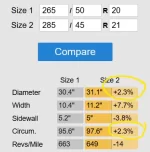There is aero for the rim and aero for the tire. Tires make up approximately 25% of the aero drag on a typical car (article in "Chinese Journal of Mechanical Engineering" linked below). The article describes measuring aero drag on three identical tires with different tread patterns (same size, construction with tread being the only difference). The Cds varied by 8% based solely on tread pattern.
The energy usage from Tire Rack article was for a Tesla Model 3 with a much smaller tire (235/40R19). The heavier Gravity will have 1.5 times the rolling resistance (6000 lbs vs 4000 lbs). The tires are wider and taller changing the aero drag. I do not think you can use these data to help understand the Gravity tire packages.
Just be resigned to the fact that the Michelin and Pirelli are equal in energy usage (mix of tire rolling, tire aero and wheel aero) while the Hankooks are obviously designed with low rolling and low aero drag.
Article discussed above:

 cjme.springeropen.com
cjme.springeropen.com
The energy usage from Tire Rack article was for a Tesla Model 3 with a much smaller tire (235/40R19). The heavier Gravity will have 1.5 times the rolling resistance (6000 lbs vs 4000 lbs). The tires are wider and taller changing the aero drag. I do not think you can use these data to help understand the Gravity tire packages.
Just be resigned to the fact that the Michelin and Pirelli are equal in energy usage (mix of tire rolling, tire aero and wheel aero) while the Hankooks are obviously designed with low rolling and low aero drag.
Article discussed above:

Aerodynamic Characteristics of Isolated Loaded Tires with Different Tread Patterns: Experiment and Simulation - Chinese Journal of Mechanical Engineering
The current research of tire aerodynamics mainly focus on the isolated and simplified tread tire. Compared with the real complex pattern tire, the tread pattern structure and deformed profile of a loaded tire has a greatly influence on tire aerodynamic drag. However, the mechanisms of the...

